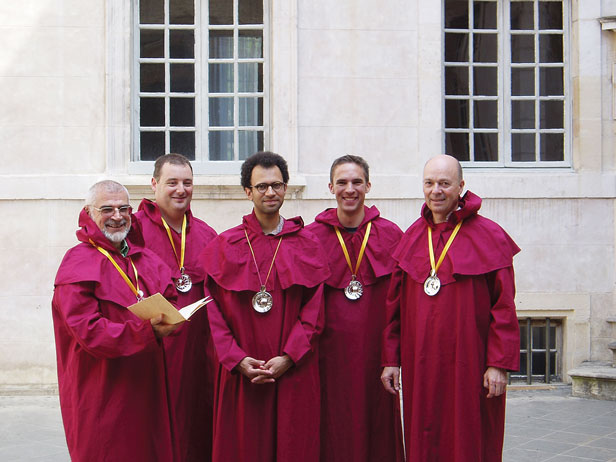
After months of experimentation, my cramped Paris apartment was beginning to resemble a mad scientist’s lab. Cans of chemicals, paints, and solvents littered the floor, and the odor of petroleum hung in the air. Scraps of paper with diagrams and equations covered the walls, and the kitchen table had been taken over by hand tools, loose hardware, and electronic components. Around the room, resting on counters, chairs, and bookcases, loaves of French bread had been mutilated in bizarre ways to accommodate secret chambers and hidden mechanisms.
A visitor confronted with this scene could have been excused for alerting the police to a baguette bomb plot. In fact, this was all the innocent work of an anthropologist.
In 2005, I was an American graduate student conducting dissertation research on the most secret of secret societies: the world of magicians. Anthropologists study different cultures by immersing themselves in members’ day-to-day lives and activities. The result is a systematic firsthand account of communities that are generally inaccessible to most casual observers.
My journey to Paris represented a pilgrimage of sorts. It was there, in the mid-19th century, that Jean-Eugène Robert-Houdin staged a seminal series of performances that changed magic forever, showcasing new tricks like human levitation and fantastical automata like a miniature mechanical bakery that produced piping-hot bite-sized pastries on command. In homage to his achievements, American magician Ehrich Weiss took the stage name Houdini. Robert-Houdin is considered the father of modern magic.
So, precisely 200 years after Robert-Houdin’s birth, I found myself in the very place where he came to make his fortune, studying how modern magic had evolved. For example, I explored the techniques magicians use to keep their skills secret in an era when information flows freely on the Internet, and I investigated how audiences now accustomed to computer-generated special effects react to manually produced illusions.
I immersed myself in the Paris magic scene, carefully observing activities in a variety of settings: magic clubs, classes, shops, museums, and performance venues. I quickly discovered that the pressures of secrecy make it difficult to be a passive observer in a world where the lines are clearly drawn between magicians and what they call “laymen.” Learning the rudiments of magic performance was a way both to earn the trust of the magicians whose experiences I hoped to describe and to better understand magic from an insider’s perspective.
I enrolled in a yearlong magic course at Les Halles community center, taught by a magician named Nemo, who became a friend and mentor. For the end of the year, our class was required to stage a magic show for our friends and family (I invited anthropologist colleagues). Inspired by Robert-Houdin’s pastry-themed routine, I set out to develop a series of tricks with baked goods.
After seeing a Parisian magician and world-class juggler named Mimosa perform an effect in which a walking stick flew in dizzying loop-de-loops around his body, I began to contemplate my own spin: a gravity-defying baguette sailing gracefully through the air. (This would also be a visual pun: in French, baguette means both a loaf of bread and a magician’s wand.)
I assumed I could simply outfit a real baguette with the same gimmick employed in Mimosa’s trick, but in an effect where less than a gram can make a world of difference, real bread was far too heavy to fly. I tried different techniques for making my baguettes more air-worthy—hollowing them, drying them, filling them with polystyrene foam—but still couldn’t perfect the weight.
Over two months, I made dozens of trips to the hardware store—and came to understand why magician Gaëtan Bloom said his favorite magic shop was the mammoth hardware store in the Bazar de l’Hôtel de Ville! My research had taught me that many magicians are inveterate tinkerers (sometimes with backgrounds in science or engineering), with rooms set aside for building magical apparatuses. Now I could identify.
When I unveiled the prototype at the monthly meeting of a magicians’ club, members assured me I had the world’s first flying baguette. Several people even offered to buy it from me, but I refused to sell. Secrets, I had learned, are a magician’s most valuable asset.
Graham Jones, assistant professor of anthropology, describes his Parisian research in the new book Trade of the Tricks: Inside the Magician’s Craft.
Keep Reading
Most Popular
Large language models can do jaw-dropping things. But nobody knows exactly why.
And that's a problem. Figuring it out is one of the biggest scientific puzzles of our time and a crucial step towards controlling more powerful future models.
The problem with plug-in hybrids? Their drivers.
Plug-in hybrids are often sold as a transition to EVs, but new data from Europe shows we’re still underestimating the emissions they produce.
Google DeepMind’s new generative model makes Super Mario–like games from scratch
Genie learns how to control games by watching hours and hours of video. It could help train next-gen robots too.
How scientists traced a mysterious covid case back to six toilets
When wastewater surveillance turns into a hunt for a single infected individual, the ethics get tricky.
Stay connected
Get the latest updates from
MIT Technology Review
Discover special offers, top stories, upcoming events, and more.